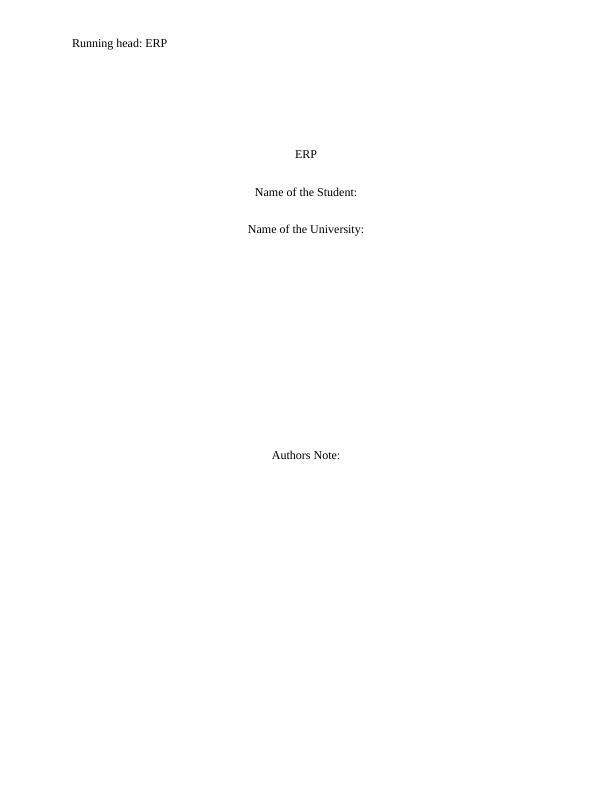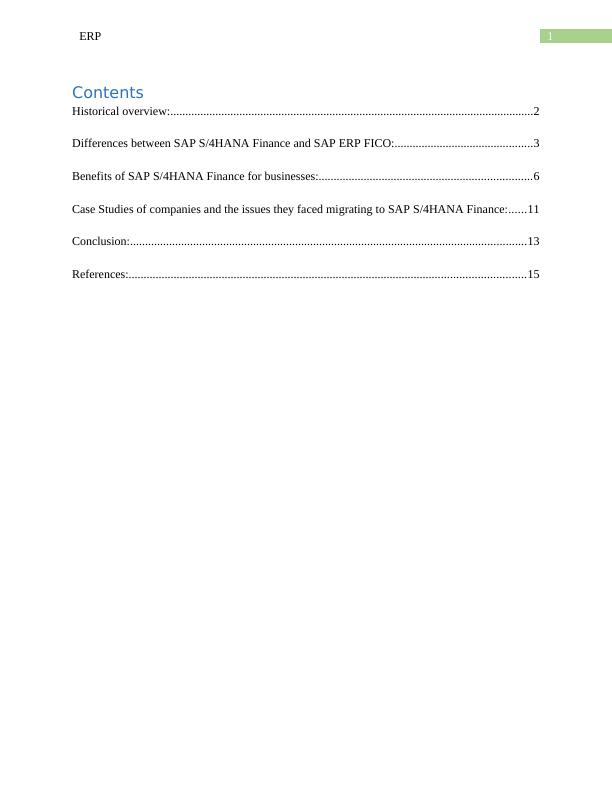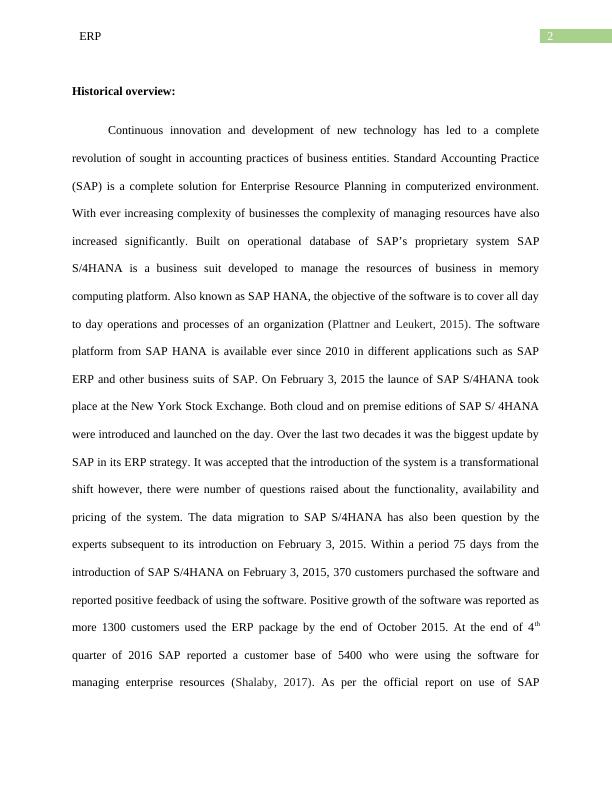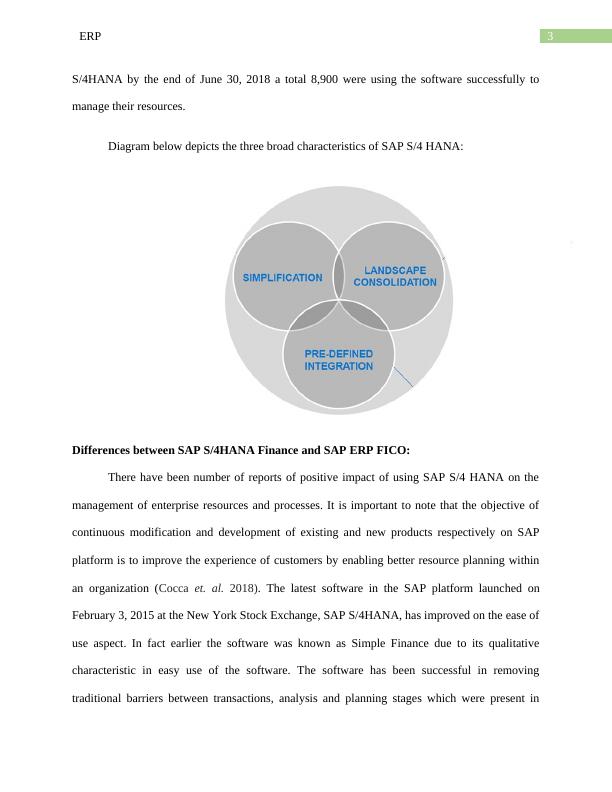ERP: Historical Overview, Differences between SAP S/4HANA Finance and SAP ERP FICO, Benefits for Businesses, Case Studies, and Issues Faced
Added on 2023-06-03
21 Pages4319 Words265 Views
Running head: ERP
ERP
Name of the Student:
Name of the University:
Authors Note:
ERP
Name of the Student:
Name of the University:
Authors Note:

1ERP
Contents
Historical overview:.........................................................................................................................2
Differences between SAP S/4HANA Finance and SAP ERP FICO:..............................................3
Benefits of SAP S/4HANA Finance for businesses:.......................................................................6
Case Studies of companies and the issues they faced migrating to SAP S/4HANA Finance:......11
Conclusion:....................................................................................................................................13
References:....................................................................................................................................15
Contents
Historical overview:.........................................................................................................................2
Differences between SAP S/4HANA Finance and SAP ERP FICO:..............................................3
Benefits of SAP S/4HANA Finance for businesses:.......................................................................6
Case Studies of companies and the issues they faced migrating to SAP S/4HANA Finance:......11
Conclusion:....................................................................................................................................13
References:....................................................................................................................................15

2ERP
Historical overview:
Continuous innovation and development of new technology has led to a complete
revolution of sought in accounting practices of business entities. Standard Accounting Practice
(SAP) is a complete solution for Enterprise Resource Planning in computerized environment.
With ever increasing complexity of businesses the complexity of managing resources have also
increased significantly. Built on operational database of SAP’s proprietary system SAP
S/4HANA is a business suit developed to manage the resources of business in memory
computing platform. Also known as SAP HANA, the objective of the software is to cover all day
to day operations and processes of an organization (Plattner and Leukert, 2015). The software
platform from SAP HANA is available ever since 2010 in different applications such as SAP
ERP and other business suits of SAP. On February 3, 2015 the launce of SAP S/4HANA took
place at the New York Stock Exchange. Both cloud and on premise editions of SAP S/ 4HANA
were introduced and launched on the day. Over the last two decades it was the biggest update by
SAP in its ERP strategy. It was accepted that the introduction of the system is a transformational
shift however, there were number of questions raised about the functionality, availability and
pricing of the system. The data migration to SAP S/4HANA has also been question by the
experts subsequent to its introduction on February 3, 2015. Within a period 75 days from the
introduction of SAP S/4HANA on February 3, 2015, 370 customers purchased the software and
reported positive feedback of using the software. Positive growth of the software was reported as
more 1300 customers used the ERP package by the end of October 2015. At the end of 4th
quarter of 2016 SAP reported a customer base of 5400 who were using the software for
managing enterprise resources (Shalaby, 2017). As per the official report on use of SAP
Historical overview:
Continuous innovation and development of new technology has led to a complete
revolution of sought in accounting practices of business entities. Standard Accounting Practice
(SAP) is a complete solution for Enterprise Resource Planning in computerized environment.
With ever increasing complexity of businesses the complexity of managing resources have also
increased significantly. Built on operational database of SAP’s proprietary system SAP
S/4HANA is a business suit developed to manage the resources of business in memory
computing platform. Also known as SAP HANA, the objective of the software is to cover all day
to day operations and processes of an organization (Plattner and Leukert, 2015). The software
platform from SAP HANA is available ever since 2010 in different applications such as SAP
ERP and other business suits of SAP. On February 3, 2015 the launce of SAP S/4HANA took
place at the New York Stock Exchange. Both cloud and on premise editions of SAP S/ 4HANA
were introduced and launched on the day. Over the last two decades it was the biggest update by
SAP in its ERP strategy. It was accepted that the introduction of the system is a transformational
shift however, there were number of questions raised about the functionality, availability and
pricing of the system. The data migration to SAP S/4HANA has also been question by the
experts subsequent to its introduction on February 3, 2015. Within a period 75 days from the
introduction of SAP S/4HANA on February 3, 2015, 370 customers purchased the software and
reported positive feedback of using the software. Positive growth of the software was reported as
more 1300 customers used the ERP package by the end of October 2015. At the end of 4th
quarter of 2016 SAP reported a customer base of 5400 who were using the software for
managing enterprise resources (Shalaby, 2017). As per the official report on use of SAP

3ERP
S/4HANA by the end of June 30, 2018 a total 8,900 were using the software successfully to
manage their resources.
Diagram below depicts the three broad characteristics of SAP S/4 HANA:
Differences between SAP S/4HANA Finance and SAP ERP FICO:
There have been number of reports of positive impact of using SAP S/4 HANA on the
management of enterprise resources and processes. It is important to note that the objective of
continuous modification and development of existing and new products respectively on SAP
platform is to improve the experience of customers by enabling better resource planning within
an organization (Cocca et. al. 2018). The latest software in the SAP platform launched on
February 3, 2015 at the New York Stock Exchange, SAP S/4HANA, has improved on the ease of
use aspect. In fact earlier the software was known as Simple Finance due to its qualitative
characteristic in easy use of the software. The software has been successful in removing
traditional barriers between transactions, analysis and planning stages which were present in
S/4HANA by the end of June 30, 2018 a total 8,900 were using the software successfully to
manage their resources.
Diagram below depicts the three broad characteristics of SAP S/4 HANA:
Differences between SAP S/4HANA Finance and SAP ERP FICO:
There have been number of reports of positive impact of using SAP S/4 HANA on the
management of enterprise resources and processes. It is important to note that the objective of
continuous modification and development of existing and new products respectively on SAP
platform is to improve the experience of customers by enabling better resource planning within
an organization (Cocca et. al. 2018). The latest software in the SAP platform launched on
February 3, 2015 at the New York Stock Exchange, SAP S/4HANA, has improved on the ease of
use aspect. In fact earlier the software was known as Simple Finance due to its qualitative
characteristic in easy use of the software. The software has been successful in removing
traditional barriers between transactions, analysis and planning stages which were present in

4ERP
earlier version of the ERP software including SAP ERP FICO. The current system, SAP
S/4HANA provides the facility of instant analysis and insights into the financial data of different
level which was not present in SAP ERP FICO. As a result the feedback from the customers of
the usefulness of the software, SAP S/4 HANA is mostly positive (Schmidt-Karaca, 2018). The
instant access to the financial data at different levels including the impact on the planning stages
of different levels within an organization helps the management to take better decisions in
managing the resources of the organization. The traditional barriers in transactions, analysis and
planning in SAP ERP FICO has made the software not as attractive as SAP S/4 HANA. The
managers of modern day business entities have to take instant decisions to ensure better
management of the organizations and their resources. The advanced software, i.e. SAP S/4
HANA have all the attributes to help the managers of business organizations in the current
competitive world to use all the features of transaction processing, analysis benefits and planning
attributes to take better decisions. In comparison the traditional barriers in SAP ERP FICO do
not allow the managers to take instant decisions. As a result of the delay in the decision making
process the business entities lost some edge to the competitors that are using advanced software
and ERP packages (Waizy et. al. 2015).
Creation of forecasts for potential decision making process is available in SAP S/4 HANA which
helps the managers to forecast the expected financial implications of different decisions. On the
basis of the forecasts the manager can take best suitable decisions for an organization. This
facility of creation of forecasts is not available in SAP ERP FICO. As a result the users of the
software lacks the competitive edge as compared to the users of SAP S/4 HANA. Further, the
creation of forecasts in SAP S/4 HANA is possible using real time financial data without any
earlier version of the ERP software including SAP ERP FICO. The current system, SAP
S/4HANA provides the facility of instant analysis and insights into the financial data of different
level which was not present in SAP ERP FICO. As a result the feedback from the customers of
the usefulness of the software, SAP S/4 HANA is mostly positive (Schmidt-Karaca, 2018). The
instant access to the financial data at different levels including the impact on the planning stages
of different levels within an organization helps the management to take better decisions in
managing the resources of the organization. The traditional barriers in transactions, analysis and
planning in SAP ERP FICO has made the software not as attractive as SAP S/4 HANA. The
managers of modern day business entities have to take instant decisions to ensure better
management of the organizations and their resources. The advanced software, i.e. SAP S/4
HANA have all the attributes to help the managers of business organizations in the current
competitive world to use all the features of transaction processing, analysis benefits and planning
attributes to take better decisions. In comparison the traditional barriers in SAP ERP FICO do
not allow the managers to take instant decisions. As a result of the delay in the decision making
process the business entities lost some edge to the competitors that are using advanced software
and ERP packages (Waizy et. al. 2015).
Creation of forecasts for potential decision making process is available in SAP S/4 HANA which
helps the managers to forecast the expected financial implications of different decisions. On the
basis of the forecasts the manager can take best suitable decisions for an organization. This
facility of creation of forecasts is not available in SAP ERP FICO. As a result the users of the
software lacks the competitive edge as compared to the users of SAP S/4 HANA. Further, the
creation of forecasts in SAP S/4 HANA is possible using real time financial data without any

5ERP
delay in data processing thus, the managers can take decisions quickly by using the ERP
software package as opposed to the users of SAP ERP FICO (Plattner and Leukert, 2015).
The following diagram shows the advantage of using S /4 HANA:
The processing speed in SAP S/4 HANA is extremely efficient. Combined with the speed of
processing data in real time the integration feature with various elements of financial accounting
and management accounting help an organization in its entire management and planning of
resources at each and every stage of the organization. Lack of speed and integration features in
SAP ERP FICO and other such software are holding back the progress of business entities in
extremely competitive modern business world (Nica et. al. 2017).
delay in data processing thus, the managers can take decisions quickly by using the ERP
software package as opposed to the users of SAP ERP FICO (Plattner and Leukert, 2015).
The following diagram shows the advantage of using S /4 HANA:
The processing speed in SAP S/4 HANA is extremely efficient. Combined with the speed of
processing data in real time the integration feature with various elements of financial accounting
and management accounting help an organization in its entire management and planning of
resources at each and every stage of the organization. Lack of speed and integration features in
SAP ERP FICO and other such software are holding back the progress of business entities in
extremely competitive modern business world (Nica et. al. 2017).

End of preview
Want to access all the pages? Upload your documents or become a member.
Related Documents
The SAP S/4HANA Finance Software: Overview, History, and Differences from SAP ERP FICOlg...
|17
|5270
|106
Computerized Accounting in ERP Systemslg...
|14
|4640
|99
SAP S/4HANA Finance: Overview, Benefits, and Issueslg...
|20
|4513
|221
Computerized Accounting in an ERP (SAP S/4HANA)lg...
|8
|1876
|138
Computerized Accounting in ERP Systemslg...
|17
|4085
|496
Computerized Accounting in ERPlg...
|17
|3906
|97
